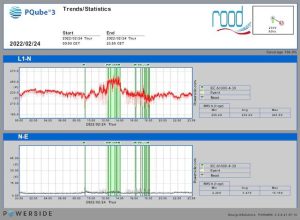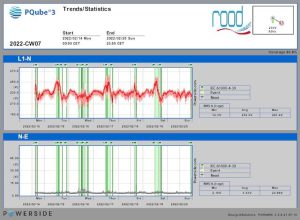Power quality – problems behind the meter
he large increase in solar and wind energy can cause voltage problems and grid failures. Many problems are behind the meter. “The electrification and large increase in solar and wind energy brings changes to the power grid. This can lead to more complexity and problems. To make a good analysis of the situation, data becomes much more important so that you know where the problems are coming from and what you can do about them,” says Arthur Hartsuiker, account manager at CN Rood power quality.
Power quality & problems
He outlines the issues we will increasingly face. “Due to an increasing number of PV installations, you may have to deal with voltage surges. If the voltage at the end of the line becomes too high due to grid impedance, the AC connection of the inverter will switch itself off for safety reasons. The maximum voltage at which an inverter should switch off is 253 V (plus 10 per cent of the rated voltage). Voltage boosting potentially entails a number of drawbacks. It can lead to power loss in the conductors, efficiency loss when the inverter switches itself off, the lifetime of the inverter may go down due to frequent switching off, and so on.”
Cause and responsibility
But what exactly is the cause and who is responsible? “The grid operator is responsible for the voltage. That should always remain 230 V plus or minus 10 per cent. If the end user delivers back to the grid, he will not immediately be the cause of voltage surges. However, if several parties – the whole district or neighbourhood – feed in, the joint feed-in may lead to problems (high grid impedance) as the load on the line becomes too high. Since the grid operator is responsible for bringing and keeping the voltage up to standard, it will try to achieve a balance using transformers. The transformer can go up so that there is more power, but then there is a user at the beginning of the line who may have a voltage that is too high. Or the voltage will be turned down. But then the first end user will not get the – 10 per cent of the voltage supplied.
“At some point, the grid operator cannot do anything more and it is ‘tuned out’. The system no longer works so another solution is needed.” Hartsuiker compares the problem to a water pipe. “If water keeps flowing there is nothing wrong, but if you turn on the tap and on the other side you also turn on the tap, you get pressure on the pipe.”
Supra-harmonic
A second phenomenon or problem that can occur is supra-harmonic distortion which can lead to disruptions or damage to equipment. “So on the normal voltage comes extra voltage. So poor power quality can also lead to problems in electrical installations.”
Only when everything adds up does it reveal what is going on.
Complexity
Voltage boosting and supra-harmonic can lead to problems in practice. But they are not easy to solve. “End users often do everything by the rules. Installers equally so. If you were to measure all houses individually, you will see that individually everything is fine. Only when everything is added together does it become visible what is going on.” Measurement data are needed. Hartsuiker gives an example: “If an entire neighbourhood with PV panels wants to supply energy back to the grid in nice weather, a PV converter will automatically switch off when the voltage is too high. Users who encounter this regularly can ask their installer what is going on. The latter can use equipment to monitor the voltage.”
“If, for example, 257 V is measured on the line for a longer period, this can be passed on to the grid operator. Standards describes how long the voltage boost is allowed. However, it is described in such a way that there have to be a lot of complaints to be outside the norm. There is a bottleneck there. There is a need for solutions to improve voltage enforcement and power quality on the power grid. But to make strides you will have to start measuring and monitoring.”


Measurements of the Powerside PQube
Private versus industry
However, Hartsuiker does not expect private individuals to monitor. “If there is a problem, the grid operator will probably investigate what is going on and see if a solution is possible. With industrial companies, the issue does become more important. If an installer is approached by a large company, he can install a meter that permanently monitors power quality. This can also detect machine failures. There, too, the cause is often a problem with power quality. Heavy machinery can cause lighting flickering in the building or in other buildings nearby. If that is the case, as an installer you can find out if the factory is disturbing the neighbourhood so that measures can be taken.”
Growing problem
Hartsuiker expects power quality problems to become much bigger in the future. “The networks are becoming more heavily loaded and we will have to be a bit more critical. In doing so, we need to monitor not only the grid but also our own installations. Super-harmonic can do a lot of damage to equipment and you want to prevent that. Measuring and monitoring is therefore necessary to find out what is going on. Many of the problems – about 80 per cent – are behind the meter. Think too much feed-in, excessive load (demand) but also unbalanced load. Such issues will become increasingly common in the future.”
